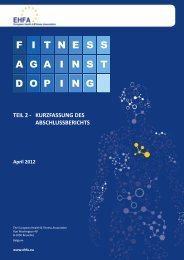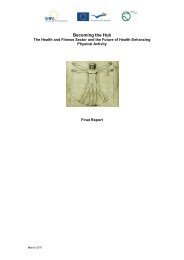FINAL REPORT - the EHFA Projects & Programmes
FINAL REPORT - the EHFA Projects & Programmes
FINAL REPORT - the EHFA Projects & Programmes
Create successful ePaper yourself
Turn your PDF publications into a flip-book with our unique Google optimized e-Paper software.
The European Fitness Sector<br />
Charter for Anti-Doping:<br />
The European health and fitness sector is<br />
committed to improving <strong>the</strong> health of its<br />
citizens and as such it is fundamentally opposed<br />
to <strong>the</strong> use of doping and o<strong>the</strong>r performanceenhancing<br />
substances that harm health. <strong>EHFA</strong><br />
and its members commit to do <strong>the</strong>ir utmost to<br />
eradicate doping practices and will cooperate<br />
with <strong>the</strong> Commission, doping agencies,<br />
authorities and governments in studying and<br />
implementing <strong>the</strong> most effective policies,<br />
campaigns and measures to combat doping.<br />
The sector will commit to educate and inform<br />
its employees and customers, and to provide<br />
information and guidance for operators to<br />
have in place effective anti-doping measures.<br />
Widespread publication and support of <strong>the</strong> Charter<br />
will ensure that all three groups – consumers,<br />
managers/owners and exercise professionals –<br />
will, over time, have a better understanding of <strong>the</strong><br />
dangers of doping. It is important that national<br />
organisations and fitness centres publicise <strong>the</strong> fact<br />
that <strong>the</strong>y have signed up to <strong>the</strong> Charter in order<br />
to ensure that <strong>the</strong> highest percentage of at-risk<br />
individuals are exposed to it.<br />
1.4.3 Create crossover anti-doping<br />
networks between <strong>the</strong> fitness sector and<br />
o<strong>the</strong>r sporting bodies<br />
The EU should establish and promote networks<br />
to combat doping in <strong>the</strong> health and fitness/<br />
unorganised sport sector. The networks should<br />
be complementary and work toge<strong>the</strong>r to ensure<br />
that <strong>the</strong> fitness/unorganised sport sectors benefit<br />
directly and residually from <strong>the</strong> work of <strong>the</strong> elite<br />
sport anti-doping agencies.<br />
Who The European Commission<br />
Member State Governments<br />
The European Fitness Sector<br />
37% of consumer respondents said that <strong>the</strong>y also<br />
played ano<strong>the</strong>r amateur sport and a significant 40%<br />
of <strong>the</strong>se admitted that <strong>the</strong>y took a performanceenhancing<br />
substance. There would appear to<br />
be an intrinsic link between doping in a fitness<br />
centre and participation in o<strong>the</strong>r competitive or<br />
unorganised sports. Elite level sport has a mature<br />
and sophisticated infrastructure at global, European<br />
and national level through anti-doping agencies<br />
which work toge<strong>the</strong>r to ensure a rigorous approach<br />
is taken to <strong>the</strong> use of drugs in sport.<br />
As has been shown by <strong>the</strong> FAD research, <strong>the</strong><br />
infrastructure of anti-doping organisations in<br />
unorganised sport and <strong>the</strong> fitness sector is virtually<br />
non-existent and <strong>the</strong>re is no European level network<br />
which brings toge<strong>the</strong>r member states’ level to<br />
ensure a consistent approach is taken.<br />
The Commission should be encouraged to consider<br />
setting up a network of member states to work<br />
toge<strong>the</strong>r to implement anti-doping strategies in<br />
amateur sport, share best practice and resources,<br />
and undertake research into <strong>the</strong> best strategies to<br />
eradicate doping and educate coaches, trainers and<br />
o<strong>the</strong>r professionals, managers and consumers of<br />
<strong>the</strong> harms of drug usage. These efforts would be<br />
supported by <strong>the</strong> European Fitness Sector.<br />
The European Fitness Sector should also be<br />
responsible for streng<strong>the</strong>ning <strong>the</strong> policies within its<br />
sector, irrespective of those in o<strong>the</strong>r amateur sport.<br />
Through its membership <strong>EHFA</strong> now represents over<br />
10,000 fitness centres across Europe and a new<br />
Code of Practice on Anti-Doping will be developed<br />
for all national associations and <strong>the</strong>ir operator<br />
members to adopt as a “zero tolerance” policy. This<br />
will include:<br />
• Model forms for conditions for fitness centre<br />
membership and usage which will stop antidoping<br />
practices<br />
• Advice on <strong>the</strong> recognition of a customer<br />
engaging in doping practices and how to<br />
intervene<br />
• A “kite” mark or symbol to be used on all<br />
literature and for a plaque or similar clearly<br />
states that it is a doping free fitness centre. This<br />
Fitness Against Doping – Executive Summary : Final Report 20




